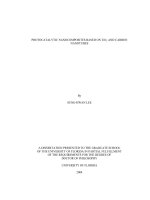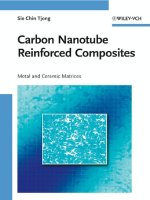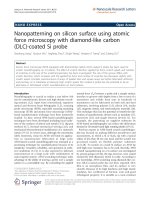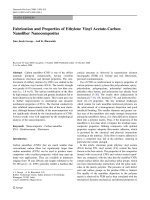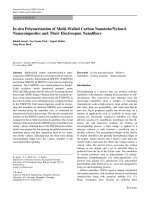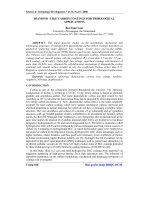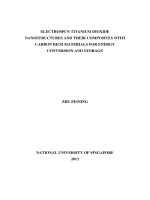Diamond and carbon composites and nanocomposites
Bạn đang xem bản rút gọn của tài liệu. Xem và tải ngay bản đầy đủ của tài liệu tại đây (5.25 MB, 180 trang )
Diamond and Carbon
Composites and Nanocomposites
Edited by Mahmood Aliofkhazraei
www.pdfgrip.com
Diamond and Carbon Composites and Nanocomposites
Edited by Mahmood Aliofkhazraei
Stole src from />Published by ExLi4EvA
Copyright © 2016
All chapters are Open Access distributed under the Creative Commons Attribution
3.0 license, which allows users to download, copy and build upon published articles
even for commercial purposes, as long as the author and publisher are
properly credited, which ensures maximum dissemination and a wider impact of our
publications. After this work has been published, authors have the right to
republish it, in whole or part, in any publication of which they are the author,
and to make other personal use of the work. Any republication, referencing or
personal use of the work must explicitly identify the original source.
As for readers, this license allows users to download, copy and build upon
published chapters even for commercial purposes, as long as the author and publisher
are properly credited, which ensures maximum dissemination and a wider impact of
our publications.
Notice
Statements and opinions expressed in the chapters are these of the individual
contributors and not necessarily those of the editors or publisher. No responsibility is
accepted for the accuracy of information contained in the published chapters. The
publisher assumes no responsibility for any damage or injury to persons or property
arising out of the use of any materials, instructions, methods or ideas contained in the
book.
Publishing Process Manager
Technical Editor
Cover Designer
AvE4EvA MuViMix Records
Спизжено у ExLib: avxhome.se/blogs/exLib
First published June 30, 2016
Stole src from />
ISBN-10: 953-51-2454-4
Спизжено у ExLib:
ISBN-13: 978-953-51-2454-2
avxhome.se/blogs/exLib
ISBN-10: 953-51-2453-6
ISBN-13: 978-953-51-2453-5
www.pdfgrip.com
www.pdfgrip.com
Contents
Preface
Chapter 1 Hardness of Thin Films and the Influential Factors
by İshak Afşin Kariper
Chapter 2 Graphene-Based Composites and Hybrids for Water
Purification Applications
by Rahul Sharma and Parveen Saini
Chapter 3 The Application of Nanodiamond in Biotechnology and
Tissue Engineering
by Lucie Bacakova, Antonin Broz, Jana Liskova, Lubica Stankova,
Stepan Potocky and Alexander Kromka
Chapter 4 Laser-Assisted Machining of Difficult to Cut Materials
by Damian Przestacki
Chapter 5 DLC Thin Films and Carbon Nanocomposite Growth by
Thermionic Vacuum Arc (TVA) Technology
by Rodica Vladoiu, Corneliu Porosnicu, Aurelia Mandes, Ionut Jepu,
Virginia Dinca, Aurelian Marcu, Mihail Lungu, Gabriel Prodan and Liga
Avotina
Chapter 6 Carbon Nanotube (CNT)-Reinforced Metal Matrix Bulk
Composites: Manufacturing and Evaluation
by Sebastian Suárez, Leander Reinert and Frank Mücklich
www.pdfgrip.com
www.pdfgrip.com
Preface
During the past few years, scientists have achieved significant
successes in nanoscience and technology. Nanotechnology is a
branch of science that deals with fine structures and materials with
very small dimensions - less than 100 nm.
The composite science and technology have also benefits from
nanotechnology.
This book collects new developments about diamond and carbon
composites and nanocomposites and their use in manufacturing
technology.
www.pdfgrip.com
www.pdfgrip.com
Chapter 1
Hardness of Thin Films and the Influential Factors
İshak Afşin Kariper
Additional information is available at the end of the chapter
/>
Abstract
Hardness is one of the most significant mechanical characteristics of a material. Hard
materials are known for their durability. Currently, diamond is the hardest substance
known in the world. Researchers have substantially worked on the production of this
expensive material. Coating this material as a thin film was also the topic of a separate
research. At the same time, hardness measurement, including the measurement of the
hardness of a thin film was a topic of research as well. In this section, we will examine
what researchers are doing for the measurement of the hardness, especially for bulk
materials.
Keywords: Nanohardness, thin films, hardness, influential factors, diamond
1. Introduction
Hard materials are very useful for the industry and technology researches. SmCo5 and Nd2Fe14B
can be used to produce televisions, video‐recording devices, and speakers, with their magnetic‐
hard properties. Even consumers need and demand hard materials because they are long‐
lasting. Hard materials are highly effective when they are used to cover a surface. They are also
used as diffusion barriers in electronic industry, as they preserve their chemical stability under
high temperature and prevent the diffusion of foreign atoms. This allows electronic materials
to be more durable than in the past (Mechanical corrosion is another important problem).
Especially in mechanical industry, these materials (hard thin films) are very useful to prevent
substances’ mechanical corrosion. Based on the aforementioned reasons, nowadays, hard thin
films have a significant place in coating.
In the abstract, we have underlined that hardness is one of the most important mechanical
characteristics of a material. You can get insights about other characteristics of the material
by
www.pdfgrip.com
2
Diamond and Carbon Composites and Nanocomposites
measuring its hardness. Hardness is an indicator of the material's resistance against scratching,
cutting, abrasion, and puncture. Table lists the hardness of some materials in terms of absolute
hardness (Table 1).
Mineral
Absolute hardness
Talk: Mg3Si4O10(OH)2
1
Gypsum: CaSO4.2H2O
2
Calcite: CaCO3
9
Fluorite: CaF2
21
Quartz: SiO2
100
Topaz: Al2SiO4(OH,F)2
200
Ruby or Sapphire: Cr–Al2O3
400
Diamond: C
1500
Table 1. Absolute hardness of some materials.
Nanoscale, that is, a few hundred nanometers in size, materials are called nanomaterials.
Thanks to nanomaterials, the technology has made great progress. The properties of a mate‐
rial in nanoscale are very different than the ones in the bulk form, which created great ad‐
vantages for the technology. Especially, coating these materials to the surface as a thin film
has added new properties to the base material. However, there is very little information in
the literature on the mechanical properties of thin films [1].
After coating process, the coated material can gain electrical, optical, corrosive, and cracking
resistance, depending on the thickness of the film. A material with such properties will be
very handy in space research, astronomy, automobile industry, and in many other areas of
engineering. For example, imagine that you can cover any surface with a heat‐resistant ma‐
terial. This can be used in a wide range of area, from space engineering to the clothing of
firefighters. On the other hand, if we could cover the surface of a material with diamond, we
could make many materials harder and at the same time more robust [2].
When you produce such materials, another problem that you will be faced will be how to
measure the hardness of the material when it is coated with such a thin film. In the litera‐
ture, the hardness of thin films is generally measured by the indentation method [3], even
though it has some limitations. The hardness of the substrate also affects the measurement,
for example, while measuring, the hardness of soft thin films or a soft substrate may affect
the hardness of the final product even though the coating that you have produced is very
hard. Thus, the type of coating and the substrate is crucial.
Researchers are currently working on the measurement of the hardness of the thin films. All
of them apply 10% rule in their studies. Accordingly, when a hollow‐shaped hole is made
on the surface of the film, the depth of this hole should be less than 10% of the film thick‐
www.pdfgrip.com
Hardness of Thin Films and the Influential Factors
/>
ness. In this way, the effect of the base material to the hardness (and to the measurement)
will be lower than 2% [4–8]. This is quite logical for the thin films, since their thickness is
lower than 1000 nm; the depth of the hole should be around 100 nm. These units can be easi‐
ly measured with the current technology [9]. In this topic, the impact of the hole's geometric
shape on the mechanical properties, that is, hardness, also attracted the attention of the re‐
searchers [3]. We can see some outstanding studies in the literature about hardness of thin
films in Table 2.
Author/s
Article
M. Draissia, H. Boudemagh,
Structure and hardness of the sputtered Al–Cu thin
Hardness of film
and M. Y. Debili
Al–Cu thin films system
according to % Cu [10]
• Lin‐Dong Wang,
Hardness measurement and evaluation None
• Min Li,
Material
film
Subject
Geometric effect [3]
of thin film on material surface
• Tai‐Hua Zhang,
• Nai‐Gang Lıang
• Seung Min Han,
Determining hardness of thin films
Al/Si, Al/
Hardness measurement
in elastically mismatched film‐on‐
sapphire,
[11]
substrate systems using
W/Si, and W/
• William D. Nix
nanoindentation
glass
Yu. A. Bykov, S. D. Karpukhin,
Measurement of the hardness of thın
TiN
Y. V. Panfilov, M. K. Boichenko,
fılms
• Ranjana Saha,
and film thickness effect
V. O. Cheptsov, and A. V. Osipov
J. L. He, W. Z. Li and H. D. Li
[12]
Hardness measurement of thin films:
TiN, Cu
separation from composite hardness
S. Chen, L. Liu, T. Wang
Measurement of hardness
Investigation of the mechanical
Measurement of hardness
[13]
Al, W
Measurement of hardness
properties of thin films by
and film thickness effect
nanoindentation, considering the effects
[14]
of thickness and different coating–
substrate combinations
Y.‐G. Jung, B. R. Lawn, M.
Evaluation of elastic modulus and
Martyniuk, H. Huang, X.Z. Hu
hardness of thin films by
None
Elastic modulus and
hardness of thin films [15]
nanoindentation
S. Liu, H. Huang, Y. T. Gu
Hardness of silicon nitride thin films
SiN
characterized by nanoindentation and
Hardness of silicon nitride
thin films [16]
nanoscratch deconvolution methods
N. Demas, C. Lorenzo‐Martin, O.O. Measurement of thin‐film coating
Ajayi, R.A. Erck, and I. Shareef
hardness in the presence of
contamination and roughness:
ımplications for tribology
www.pdfgrip.com
TiAlN, CrN
Hardness of thin film
effect on tribology [17]
3
4
Diamond and Carbon Composites and Nanocomposites
Author/s
Article
P. D. Tall, S. Ndiaye, A. C. Beye, Z. Nanoindentation of Ni–Ti thin films
Zong, W. O. Soboyejo, H.‐J. Lee, A.
Material
Subject
Ni–Ti
Hardness of alloys thin
film [18]
G. Ramirez, K. Rajan
Table 2. Hardness of thin films in the literature.
In this chapter, we tried to formulize and explain the methods that can be used to measure the
hardness of a thin film, the parameters affecting the hardness of a thin film, and the impacts
of other parameters such as temperature, elasticity module, which also affect hardness, on the
thin films.
2. Methods
The logic of hardness measurement is to indent the material to be tested with another material,
whose hardness is known, and measure the resistance that the tested material displayed
against it. The material that is used to measure the hardness (indenter) should be much harder
than the tested material. Thus, mechanical defects that may occur during the measurement
would be equilibrated. The geometric shape of the indenter is also important. It is usually
chosen among the geometric shapes whose area can easily be calculated, such as ball (sphere),
pyramid, or cone.
The usual method to achieve the hardness is to form a scratch, having an area (A), using an
indenter by applying a specific force (F). Therefore, hardness H is
F
H =
A
(1)
The area (A) formed on the surface of the material is negatively proportional with the hardness
of the material. The following precautions should be taken while making the measurements:
1.
The measurement should be made on a flat surface.
2.
The thickness of the test material should be at least 10 times bigger than the depth of the
indent (Therefore, microhardness measurements are not very suitable for thin films).
3.
Hardness measurement should be made at the center of the sample.
Currently, four methods can be mentioned for hardness measurement, as described in the
following sections.
2.1. Brinell's hardness test
Brinell's hardness test consists of indenting a sphere with a 10 mm diameter into the material
(Figure 1).
www.pdfgrip.com
Hardness of Thin Films and the Influential Factors
/>
Figure 1. Brinell's hardness test.
Here, F is the applied force; D is the diameter of the indenter; and d is the diameter of the
indentation.
H=
2F
µD( D - W D 2 - d 2 )
(2)
The force to be applied is calculated according to F = CD2, where C is the loading degree,
varying for each material.
2.2. Rockwell's hardness test
It is similar to the Brinell hardness test; however, in this test, the holes between the surface of
the sample and the indenter is equilibrated by applying a force of 10 kg. Then, an additional
major load is applied and removed, while the preliminary load is still maintained (Figure 2).
Figure 2. Rockwell's hardness test.
2.3. Vickers hardness test
In this test, force F is applied by a diamond indenter, in the form of a right pyramid with an
angle of 136° between opposite faces (Figure 3). The calculations are made by measuring the
diagonals of the indentation left on the surface of the material.
www.pdfgrip.com
5
6
Diamond and Carbon Composites and Nanocomposites
Figure 3. Vickers test and the indentation left in the surface of the material.
Figure 4. Indentation of the diamond into the material.
Using d1 displayed above, d can be calculated as d = (d1 + d2)/2. And the hardness can be
calculated as
H = 1.8544
F
d2
Hardness of thin films can be measured with this method by using AFM devices.
www.pdfgrip.com
(3)
Hardness of Thin Films and the Influential Factors
/>
2.4. Microhardness test
This method is suitable to measure the hardness of micron‐sized samples. Similar to the Vickers
test, a diamond indenter, in the form of a right pyramid, with an angle of 136° or 172°, is used
(Figure 4). The hardness is
H = 14.2
F
d2
(4)
where d is the length of the indented edge [19].
3. Hardness of thin films
Researchers started to conduct researches on hard thin films and to produce them, because it
became more and more important for the industry and the technology. Since the hardness
measurement is as important as the thin films themselves, many researchers have focused on
this issue as well. In various studies conducted until today, it has been indicated that the
hardness of thin films can be calculated by indent images taken through nano‐indentation
device or AFM device (Figure 5).
In fact, these hardness measurements are also performed in a way similar to Vickers testing
that we have explained above. The copper triple needle probe, which is used for tapping mode
in AFM device, is indented to the surface by applying a particular force.
Figure 5. Hardness measurement by AFM.
The hardness of thin films can be determined using Vickers formulas (Eq. (3)), through the
pyramid‐shaped indentation seen on the surface image of the film. Here, measuring the
www.pdfgrip.com
7
8
Diamond and Carbon Composites and Nanocomposites
hardness of the substrate along with the thin film is very important. Otherwise, you may end
up measuring the hardness of the substrate, instead of the hardness of the nanometer‐thick
film. Therefore, it may be useful to compare the hardness of the substrate with the hardness
of the film. To prevent this, researchers often use the following formulas:
Ec =
pS
2b A
(5)
where Ec: composite modulus,
S: measured stiffness,
B: Berkovich‐type constant: 1.034.
Mechanical problems that may occur due to the substrate can be eliminated by shifting to the
Young module Em value:
Em =
(1 - v )
2
m
1 1 - vi2
E*
Ei
(6)
where υ is the Poisson ratio and E is the Young module, representing the characteristics of the
indenter and tested material with subindices “i” and “m”. In this process, Young's module can
be computed by replacing the indices with the tested film and the substrate, and the hardness
of the film can be calculated.
Many researchers have worked on the hardness of thin films and described the parameters
affecting the hardness of thin films. Some structural characteristics of thin films affect their
optical, electrical, and mechanical properties. For example, it has been proven that electrical
resistance of a thin film can be increased by decreasing its thickness; or film thickness and optic
band gap are negatively proportional. However, researchers are a little late to investigate the
impact of these parameters on the mechanical properties of thin films. On the other hand, there
are researchers, such as Kariper, who have demonstrated that surface tension and surface
energy of thin films are correlated with film thickness, average grain size, and number of
crystalline per unit area.
According to literature, López et al. showed that film thickness and film hardness are nega‐
tively correlated [20]. Cavaleiro and Louro also observed that hardness is negatively correlated
with grain size [21].
Due to the deformation of thin films, Ferro et al. could only show that there is a negative relation
between thickness and hardness of the film: (i) the boundary between the film surface and the
base prevents disordered structures and cracks, (ii) at the same time, nanocrystal nature of the
films increases disordered structures. Therefore, it has been concluded that the decrease in the
film thickness increases film tension of the area during the creation of the indent and causes
www.pdfgrip.com
Hardness of Thin Films and the Influential Factors
/>
the indent to be deeper; and this process prevents plastic deformation. These explanations
have convergent parts with our interpretation [22].
Venkatraman and Bravman suggested that––based on the Hall–Petch effect––as the grain size
decreases, structural dislocation decreases, and this process increases the flow stress [23].
Figure 6. X‐ray patterns of Mn2V2O7 films with different deposition time: (a) 10 min, (b) 20 min, (c) 30 min, and (d) 40
min [24].
Kariper has published enormous and very clear works about the hardness of thin films and
the influential factors [24]. He has demonstrated that parameters of thin films such as film
thickness, grain size, surface roughness, etc. have affected the hardness of thin films. He had
coated amorphous glass substrates with Mn2V2O7 thin films. He showed that thickness and
average grain size of the films varied with deposition time (The graphs and figures are taken
from (and reorganized) the paper of Kariper published in the International Journal of Minerals,
Metallurgy and Materials, in 2015). The lattice parameters of Mn2V2O7 thin films were: a = 0.6879
nm, b = 0.7973 nm, c = 1.0948 nm, and the angles are α = 87.92°, β = 72°, γ = 83.29°. The location
www.pdfgrip.com
9
10
Diamond and Carbon Composites and Nanocomposites
of atoms in the plane is displayed in Figure 6 and Tables 3 and Tables 4. The peaks of the films
were indexed with ASTM values (47‐0342).
The researcher had measured the film thickness through AFM tapping mode; he calculated
average grain size and number of crystalline per unit area through Scherrer's formulas; the
obtained results are presented in Figures 7 and Figures 8.
Figure 7. Film thickness, average grain size and roughness versus deposition time [24].
Figure 8. Number of crystalline per unit area and dislocation density of the films versus deposition time [24].
Deposition time (min.)
Film thickness (nm)
Grain size (nm)
Roughness (nm)
10
157
36
17
20
174
38
21
30
218
40
29
40
266
45
45
Table 3. Some parameters of the thin film according to deposition time [24].
www.pdfgrip.com
Hardness of Thin Films and the Influential Factors
/>
Deposition time (min)
Number of crystalline per unit area (1/nm2)
10
4,81
20
3,72
30
1,32
40
0,192
Table 4. Number of crystalline per unit area of the thin film according to deposition time [24].
Figure 9. AFM images of the films with different deposition times (a) 10 min, (b) 20 min, (c) 30 min, and (d) 40 min
[24].
He also stated that surface roughness affects hardness and published AFM surface images
(Figure 9).
Afterward, he plotted the important parameters of thin films, such as film thickness, average
grain size, surface roughness, and number of crystalline per unit area, in the form of a graph
to find out if they are correlated with hardness (Figure 10 and Figure 11, and Table 5 (a) and
(b)).
www.pdfgrip.com
11
12
Diamond and Carbon Composites and Nanocomposites
Figure 10. Relation between film thickness, average grain size, and hardness [24].
Figure 11. Relation between number of crystalline per unit area, roughness, and hardness [24].
Deposition time (min.)
Number of crystalline per unit area (1/nm2)
Roughness (nm)
Hardness (kg/mm2)
10
4,81
17
663
20
3,72
21
651
30
1,32
29
613
40
0,192
45
604
Table 5. (a) Some parameters of the thin film according to hardness [24].
www.pdfgrip.com
Hardness of Thin Films and the Influential Factors
/>
Deposition time (min.)
Film thickness (nm)
Average grain size (nm)
Hardness (kg/mm2)
10
157
36
663
20
174
38
651
30
218
40
613
40
266
45
604
Table 5. (b) Some parameters of the thin film according to hardness [24].
He achieved important findings with the outcomes of these graphs:
H = -1.6343t + 1237.9 (H: hardness, t: film thickness)
H= -0.1222D + 117.09 (H: hardness, D: average grain size)
H= 0.0738N + 44.162 (H: hardness, N: number of crystalline per unit area)
H= -0.3931R + 276.76 (H: hardness, R: roughness)
In spite of some small experimental errors, he suggested that these formulas can be combined,
and can be expressed as follows:
H = 0.01845N - 0.4086t – 0.03055D – 0.0983R + 418.978.
4. Elasticity module of thin films
Hooke is a British scholar who lived in London between the years 1635 and 1703, and he
provided great convenience to the concept of strength with the law he has discovered. Hooke
has formed his law for isotropic material as follows:
For instance, let us take two different steel bars and apply two different forces (F1 and F2) to
these bars in the dynamometer. Steel bars will be affected by two different tensions, σ1 and
σ2, where σ1 = F1/A1 and σ2 = F2/A2. We can find out the elongation of the bars, ∆L1 and ∆L2.
The ratio of these elongations to L01 and L02 gives us the stretching. It can be find “elasticity
module,” E, which is one of the main characteristics of a material, by writing the formulas of
these elongations and divide them to the tensions that we have calculated above. Thomas
Young first found this value; thus, it is called as “Young's modulus” in the literature.
Here, we cannot measure the elongation of flexible thin films, because we have coated them
on a substrate. However, we can get insights about their elasticity module and elasticity
indirectly and make comparisons (σ = Eε, where E is elasticity module and ε is unit elongation).
1/Eα - 1.6343t + 1237.9 (t: film thickness)
1/Eα - 0.1222D + 117.09 (D: average grain size)
1/Eα 0.0738N + 44.162 (N: number of crystalline per unit area)
1/Eα -0.3931R + 276.76 (R: roughness)
www.pdfgrip.com
13
14
Diamond and Carbon Composites and Nanocomposites
1/Eα 0.01845N - 0.4086t – 0.03055D – 0.0983R + 418.978.
Therefore, the elasticity of a flexible thin film is negatively correlated with average grain size,
film thickness, and surface roughness, whereas it is positively correlated with the number of
crystalline per unit area. On the other hand, since most of the flexible thin films are polymer
or organic composites, it is quite difficult to obtain crystalline structure of these films. There‐
fore, it is more appropriate to make a relationship between film thickness and elasticity
module.
5. Tensile and yield strength
Tensile and yield strength of thin films are among the features that cannot be measured
directly. For the films whose hardness is measured, these features can be computed indirectly
as below:
ỉ H ưỉ n ử
TS = ỗ
ữỗ
ữ
ố 2.9 ứố 0.217 ứ
n
n
ổHử
YS = ỗ ữ ( 0.1)
è 3ø
(7)
(8)
where TS: tensile strength;
YS: yield strength;
n: strain hardening exponent. Cahoon et al. [25] stated that they were able to calculate tensile
and yield strengths with less than 2% error using these formulas. But, the computation of “n”
value was posing problems. Thus, Pavlina and Van Tyne [26] have made some experiments
and arranged these formulas as below:
YS = -90.7 + 2.876 H
(9)
TS = -99.8 + 3.734 H
(10)
Therefore, tensile and yield strengths can be directly computed from hardness measurements.
Combining these with Kariper's formulas,
YS = 3469.5 – 4.700t (t: film thickness)
YS = 246.05 – 0.35144D (D: average grain size)
YS = 36.309 + 0.21224N (N: number of crystalline per unit area)
www.pdfgrip.com
Hardness of Thin Films and the Influential Factors
/>
YS = 705.26 – 1.130R (R: surface roughness)
Total YS = 0.21224N – 4.700t – 0.35144D – 1.130R + 1114.279.
Similarly, for TS,
TS = 4522.51 – 6.1024t (t: film thickness)
TS = 337.41 – 0.456D (D: average grain size)
TS = 65.100 + 0.2755N (N: number of crystalline per unit area)
TS = 933.62 – 1.467R (R: roughness)
Total TS = 0.2755N – 6.1024t – 0.456D – 1.467R + 1464.66.
As can be seen from these formulas, tensile and yield strengths are negatively correlated with
film thickness, average grain size, and surface roughness (in other words, tensile and yield
strengths of a thin film decrease as these parameters increase), whereas they are positively
correlated with the number of crystalline per unit area (in other words tensile and yield
strengths increase as the number of particles per unit area increases).
6. The relationship between temperature and hardness
The variation of the hardness of a material with temperature is another important issue. The
most significant study of this area has been conducted by Volinsky et al. [27], on gold and
copper films, in which they have attempted to explain the correlation of yield strength with
temperature. Volinsky et al. have formulized their findings as below:
YS (T ) = YS0 + AT 2 + BT
(11)
where A and B are constants, whereas YS0 is the yield strength of the material at 0°C. Com‐
bining this with Kariper's formulas,
YS0 + AT2 + BT = 3469.5 – 4.700t (t: film thickness)
YS0 + AT2 + BT = 246.05 – 0.35144D (D: average grain size)
YS0 + AT2 + BT = 36.309 + 0.21224N (N: number of crystalline per unit area)
YS0 + AT2 + BT = 705.26 – 1.130R (R: surface roughness)
YS0 + AT2 + BT = 0.21224N – 4.700t – 0.35144D – 1.130R + 1114.279.
We can transform them into Kariper's formulas as described above. With the help of these
formulas, yield strength of a film can be computed by measuring its hardness and the param‐
eters such as film thickness, average grain size, number of particles per unit area, and surface
www.pdfgrip.com
15
16
Diamond and Carbon Composites and Nanocomposites
roughness. This may allow us to get rid of very expensive XRD operations. The only reason
for not using these formulas is that we have not measured the hardness of Manganese–
Vanadate films at 0°C yet.
7. Sensitivity coefficient
While measuring the hardness of a material, many parameters, such as force, diameter, depth,
time, etc. affect the outcome of the measurement. These parameters also cause an uncertainty
on measurement. The relationship of this uncertainty with the hardness is given as below:
DH
c =
Dx
(12)
where Δx is the input parameter that has been changed. With sensitivity coefficient, we can
get insight about the accuracy of hardness measurement. The opposite is also true. Sensitivity
coefficients can be computed from hardness measurements. Most of the sensitivity coefficients
can be obtained from the literature.
Table 6 shows the list prepared by Ludvik [28], showing the hardness the thin films pro‐
duced until now.
Material
Microhardness (GPa)
Classification
c‐BN
50–70
Superhard
CN
50–60
Superhard
nc‐TiCN/SiCN
30–60
Hard–Superhard
nc‐TiN/SiN
30–50
Hard–Superhard
TiN
20–30
Hard
SiCN
25–35
Hard
SiC
20–30
Hard
SiN
20
Soft–Hard
SiON
10–20
Soft
TiO2
About 10
Soft
Ta2O5
About 10
Soft
Nb3O5
About 10
Soft
SiO2
About 10
Soft
Table 6. Microhardness of PVD and CVD films with commonly used substrates [19].
www.pdfgrip.com
Hardness of Thin Films and the Influential Factors
/>
8. Conclusion
Nowadays, the mechanical properties of thin films, which have a very important role in the
development of nanotechnology, attract the attention of the researchers. The hardness of the
material changes when its surface is covered with a hard or soft material, which especially
makes the material more useful in many areas of the industry and technology. Examining the
factors that affect the hardness of the material will make a very big contribution to the literature,
as well as to the industry and technology.
In this section, we briefly discussed what hardness is, what the logic of hardness measurements
is, and how they are performed. We mostly focused on the hardness of thin films. We extended
the formulas of Kariper, who conducted the most comprehensive studies in this area, and we
revealed that we can calculate elasticity module, Young's module, yield strength, and tensile
strength of a thin film indirectly, or at least that we can make comparisons using these formulas.
In addition, we combined the temperature change formulas of Volinsky et al. with Kariper's
formula and saw that we can get insight about the characteristics of a thin film, such as film
thickness, average grain size, and number of crystalline per unit area from different hardness
measurements of the material performed at different temperatures.
Therefore, in this chapter, we presented the methods required to measure the hardness of a
thin film, which are frequently emphasized by the researchers. We examined the factors that
affect the hardness of thin films, which is one of the most important properties, and we showed
how Kariper formulized them. Moreover, we explained the impact of these parameters on
various properties of a thin film, such as elasticity module, Young's module, yield strength,
and tensile strength, and we introduced significant novelties and hypothesis to the literature.
We hope that this study will be a milestone for other researchers who work in this area.
Author details
İshak Afşin Kariper*
Address all correspondence to:
Erciyes University, Faculty of Education, Kayseri, Turkey
References
[1] S.R.J. Saunders, H.R. Vetters, Standardisation of test methods for the mechanical
properties of thin coatings. Thin Solid Films, 299 (1997) 82–87.
www.pdfgrip.com
17
